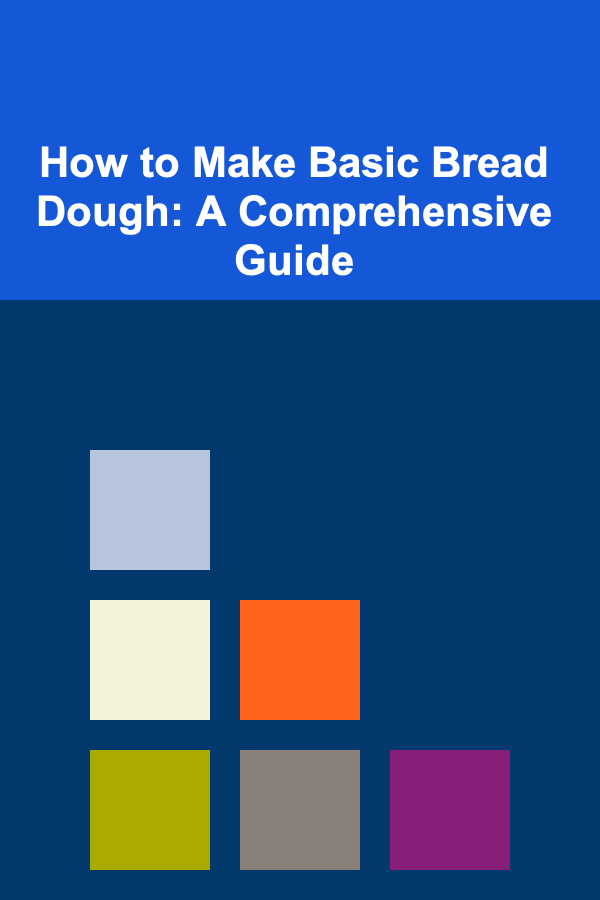
How to Make Basic Bread Dough: A Comprehensive Guide
ebook include PDF & Audio bundle (Micro Guide)
$12.99$10.99
Limited Time Offer! Order within the next:

Making bread from scratch is one of the most rewarding cooking experiences. The aroma of freshly baked bread, the warm texture, and the sense of accomplishment that comes with making something from the simplest ingredients are unparalleled. Bread dough forms the foundation of almost all types of bread, from soft sandwich loaves to crunchy baguettes, and learning how to make it can open the door to countless possibilities in your kitchen.
In this guide, we will walk you through the process of making a basic bread dough. This dough can be the start of many types of bread and can be adapted with variations to suit different recipes. We will explore the essential ingredients, step-by-step instructions, tips, and troubleshooting to help you master this fundamental skill in baking.
The Essential Ingredients of Basic Bread Dough
Before we dive into the process, it's important to understand the basic ingredients that go into making bread dough. Each of these ingredients plays a crucial role in creating the texture, flavor, and structure of the bread. Let's take a closer look at the key components:
1. Flour
Flour is the primary ingredient in bread dough. The type of flour you use will determine the texture and density of your bread. All-purpose flour is commonly used in many bread recipes, but for a chewier, denser texture, you can use bread flour . Bread flour has a higher protein content, which helps develop gluten, giving the bread a more elastic texture. For a lighter, fluffier loaf, you might want to use cake flour or a mixture of different flours.
2. Water
Water is necessary for hydrating the flour and activating the yeast. The amount of water will depend on the type of flour and the desired dough consistency. The water should be warm (but not hot) when mixing with yeast to activate it. Too hot or too cold water can prevent the yeast from activating properly.
3. Yeast
Yeast is a microorganism that ferments the sugars in flour and produces carbon dioxide gas, which causes the dough to rise. There are two main types of yeast used in bread making:
- Active dry yeast: This is the most common form of yeast used in home baking. It needs to be dissolved in warm water before adding it to the flour.
- Instant yeast: This type of yeast can be mixed directly into the flour without needing to be dissolved in water. It's faster-acting than active dry yeast.
4. Salt
Salt is an essential ingredient in bread dough. It enhances the flavor of the bread and helps control the yeast's activity. Salt regulates the fermentation process, slowing it down and allowing for better flavor development.
5. Sugar (Optional)
While sugar is not strictly necessary in basic bread dough, it can be added to help feed the yeast, accelerating the fermentation process and resulting in a slightly sweeter loaf. It also contributes to browning during baking.
6. Fat (Optional)
Fat, such as butter, olive oil, or vegetable oil, is often included in bread recipes to add moisture, flavor, and a softer texture. Fat can also help keep the bread fresher for longer.
Step-by-Step Guide to Making Basic Bread Dough
Now that we know the ingredients, it's time to make the dough. Below is a step-by-step guide on how to make basic bread dough. Follow each step carefully to ensure the best results.
Step 1: Prepare the Yeast Mixture
Start by preparing the yeast. If you're using active dry yeast, dissolve it in about 1/4 cup of warm water (not hot, around 110°F or 43°C) with a teaspoon of sugar. Stir it gently and let it sit for about 5-10 minutes. You should see the mixture foam and bubble as the yeast activates. If this doesn't happen, the yeast may be dead, and you'll need to try with a new batch.
If you're using instant yeast, you can skip this step and mix it directly with the flour in the next steps.
Step 2: Mix the Dry Ingredients
In a large mixing bowl, combine your flour and salt. Stir them together to ensure the salt is evenly distributed throughout the flour. If you're using sugar, you can add it at this point too. Make a well in the center of the flour mixture.
Step 3: Add the Wet Ingredients
Pour the activated yeast mixture into the well you created in the flour. If you're using instant yeast, simply add it to the flour along with the water. Add any additional ingredients, such as fat (butter or oil), if your recipe calls for it.
Using a wooden spoon or your hands, slowly begin to incorporate the flour into the wet ingredients. Gradually add the remaining water, a little at a time, until the dough begins to come together. You want the dough to be slightly sticky but not too wet.
Step 4: Knead the Dough
Once the dough starts coming together, transfer it to a clean, lightly floured surface. Begin kneading the dough by pressing it with the heels of your hands, folding it over, and rotating it a quarter turn. Continue kneading for about 8-10 minutes until the dough becomes smooth and elastic. If the dough sticks to your hands, sprinkle it with a small amount of flour.
Kneading helps to develop the gluten in the dough, which gives the bread its chewy texture. If you press the dough with your finger and it springs back, it's a good sign that the gluten is developing.
Step 5: First Rise (Fermentation)
Once the dough is kneaded, place it in a clean bowl and cover it with a damp cloth or plastic wrap. Let it rise in a warm, draft-free area for about 1-2 hours, or until the dough has doubled in size. This is the fermentation process, during which the yeast will produce gas and cause the dough to rise.
Step 6: Punch Down the Dough
After the dough has doubled in size, punch it down gently to release the air trapped inside. This step helps to redistribute the yeast and makes the bread more uniform in texture. Once the dough has been punched down, you can shape it into loaves or rolls.
Step 7: Shape the Dough
Shape your dough into the desired form, whether that's a round loaf, a baguette, or small rolls. To shape the dough, flatten it out into a rectangle, then fold the edges inward toward the center. Roll it tightly and pinch the seams together. Place the dough onto a lightly greased baking sheet or into a loaf pan, depending on your preference.
Step 8: Second Rise
Cover the shaped dough with a damp cloth or plastic wrap and let it rise again for about 30-60 minutes, or until it has nearly doubled in size. This is known as the second rise, and it helps develop the final texture of the bread.
Step 9: Preheat the Oven
While the dough is rising, preheat your oven to 375°F (190°C). If you're making a crustier loaf, you can place a small pan of water on the bottom rack of the oven to create steam, which will give the bread a crispy crust.
Step 10: Bake the Bread
Once the dough has risen for the second time, place it in the preheated oven. Bake it for 25-35 minutes, or until the bread is golden brown and sounds hollow when tapped on the bottom. The exact baking time may vary depending on the size and shape of your loaf.
Step 11: Cool the Bread
After removing the bread from the oven, allow it to cool on a wire rack. This helps prevent the crust from becoming soggy as it cools. Let the bread cool completely before slicing it, as cutting into hot bread can result in a gummy texture.
Tips for Perfect Bread Dough
- Temperature: Make sure the water used for activating yeast is not too hot or cold. Water that is too hot can kill the yeast, while cold water will not activate it.
- Kneading: Kneading is essential for developing gluten, which gives the bread structure and texture. If you're kneading by hand, be patient and knead for at least 8-10 minutes.
- Resting Time: Allow enough time for both rises. Rushing the fermentation process can lead to dense, underdeveloped bread.
- Humidity: If you're baking in a particularly dry environment, consider adding a little extra water to the dough to prevent it from becoming too dry.
- Flour: Different flours absorb different amounts of water, so you may need to adjust the amount of water depending on the type of flour you're using.
Troubleshooting
If your bread doesn't turn out as expected, there are a few common issues to consider:
- Bread is too dense: This can happen if the dough wasn't kneaded enough or if it didn't rise properly. Ensure you're kneading for the right amount of time and giving the dough enough time to rise.
- Bread doesn't rise: If the dough doesn't rise, it could be because the yeast is old, the water was too hot or cold, or the dough was placed in a drafty area. Make sure your yeast is fresh, and your rising environment is warm and draft-free.
- Bread is too dry: If your bread turns out dry, you may not have added enough water or fat to the dough. Try adding a little more liquid or fat in your next batch.
Conclusion
Making basic bread dough is a simple yet rewarding process that allows you to create delicious, fresh bread at home. With just a few ingredients and some patience, you can make a variety of breads, from soft dinner rolls to hearty loaves. By following the steps outlined in this guide, and with practice, you'll be able to create perfect bread dough every time. So grab your apron, get your hands in the dough, and start baking!

Affordable Options for Pet Grooming and Vet Care: Top Tips for Budget-Conscious Pet Owners
Read More
How to Create a Holiday Photo Wall
Read More
How to Streamline Your Project Management for Higher Rates
Read More
How to Track Your Gardening Goals and Achievements
Read More
How to Get Better Sleep for Mental Well-being
Read More
How to Build a Relationship To-Do List for Introverts
Read MoreOther Products

Affordable Options for Pet Grooming and Vet Care: Top Tips for Budget-Conscious Pet Owners
Read More
How to Create a Holiday Photo Wall
Read More
How to Streamline Your Project Management for Higher Rates
Read More
How to Track Your Gardening Goals and Achievements
Read More
How to Get Better Sleep for Mental Well-being
Read More